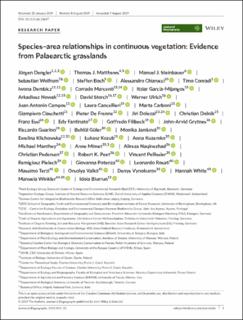Please use this identifier to cite or link to this item:
https://doi.org/10.21256/zhaw-18224| Publication type: | Article in scientific journal |
| Type of review: | Peer review (publication) |
| Title: | Species–area relationships in continuous vegetation : evidence from Palaearctic grasslands |
| Authors: | Dengler, Jürgen Matthews, Thomas J. Steinbauer, Manuel J. Wolfrum, Sebastian Boch, Steffen Chiarucci, Alessandro Conradi, Timo Dembicz, Iwona |
| et. al: | Yes |
| DOI: | 10.1111/jbi.13697 10.21256/zhaw-18224 |
| Published in: | Journal of Biogeography |
| Volume(Issue): | 47 |
| Issue: | 1 |
| Page(s): | 72 |
| Pages to: | 86 |
| Issue Date: | 19-Sep-2019 |
| Publisher / Ed. Institution: | Wiley |
| ISSN: | 0305-0270 1365-2699 |
| Language: | English |
| Subjects: | Species-area relationship; Grassland |
| Subject (DDC): | 577: Ecology |
| Abstract: | Aim: Species-area relationships (SARs) are fundamental scaling laws in ecology although their shape is still disputed. At larger areas power laws best represent SARs. Yet, it remains unclear whether SARs follow other shapes at finer spatial grains in continuous vegetation. We asked which function describes SARs best at small grains and explored how sampling methodology or the environment influence SAR shape. Location: Palaearctic grasslands and other non-forested habitats. Taxa: Vascular plants, bryophytes and lichens. Methods: We used the GrassPlot database, containing standardised vegetation-plot data from vascular plants, bryophytes, and lichens spanning a wide range of grassland types throughout the Palaearctic and including 2057 nested-plot series with at least seven grain sizes ranging from 1 cm2 to 1024 m². Using non-linear regression, we assessed the appropriateness of different SAR functions (power, power quadratic, power breakpoint, logarithmic, Michaelis-Menten). Based on AICc, we tested whether the ranking of functions differed among taxa, methodological settings, biomes or vegetation types. Results: The power function was the most suitable function across the studied taxonomic groups. The superiority of this function increased from lichens to bryophytes to vascular plants to all three taxonomic groups together. The sampling method was highly influential as rooted-presence sampling decreased the performance of the power function. By contrast, biome and vegetation type had practically no influence on the superiority of the power law. Main conclusions: We conclude that SARs of sessile organisms at smaller spatial grains are best approximated by a power function. This coincides with several other comprehensive studies of SARs at different grain sizes and for different taxa, thus supporting the general appropriateness of the power function for modelling species diversity over a wide range of grain sizes. The poor performance of the Michaelis-Menten function demonstrates that richness within plant communities generally does not approach any saturation, thus calling into question the concept of minimal area. |
| URI: | https://digitalcollection.zhaw.ch/handle/11475/18224 |
| Fulltext version: | Published version |
| License (according to publishing contract): | CC BY 4.0: Attribution 4.0 International |
| Departement: | Life Sciences and Facility Management |
| Organisational Unit: | Institute of Natural Resource Sciences (IUNR) |
| Appears in collections: | Publikationen Life Sciences und Facility Management |
Files in This Item:
| File | Description | Size | Format | |
|---|---|---|---|---|
| 2019_Dengler_et_al-Species-area relationships in continuous vegetation.pdf | 3.09 MB | Adobe PDF |  View/Open |
Show full item record
Dengler, J., Matthews, T. J., Steinbauer, M. J., Wolfrum, S., Boch, S., Chiarucci, A., Conradi, T., & Dembicz, I. (2019). Species–area relationships in continuous vegetation : evidence from Palaearctic grasslands. Journal of Biogeography, 47(1), 72–86. https://doi.org/10.1111/jbi.13697
Dengler, J. et al. (2019) ‘Species–area relationships in continuous vegetation : evidence from Palaearctic grasslands’, Journal of Biogeography, 47(1), pp. 72–86. Available at: https://doi.org/10.1111/jbi.13697.
J. Dengler et al., “Species–area relationships in continuous vegetation : evidence from Palaearctic grasslands,” Journal of Biogeography, vol. 47, no. 1, pp. 72–86, Sep. 2019, doi: 10.1111/jbi.13697.
DENGLER, Jürgen, Thomas J. MATTHEWS, Manuel J. STEINBAUER, Sebastian WOLFRUM, Steffen BOCH, Alessandro CHIARUCCI, Timo CONRADI und Iwona DEMBICZ, 2019. Species–area relationships in continuous vegetation : evidence from Palaearctic grasslands. Journal of Biogeography. 19 September 2019. Bd. 47, Nr. 1, S. 72–86. DOI 10.1111/jbi.13697
Dengler, Jürgen, Thomas J. Matthews, Manuel J. Steinbauer, Sebastian Wolfrum, Steffen Boch, Alessandro Chiarucci, Timo Conradi, and Iwona Dembicz. 2019. “Species–Area Relationships in Continuous Vegetation : Evidence from Palaearctic Grasslands.” Journal of Biogeography 47 (1): 72–86. https://doi.org/10.1111/jbi.13697.
Dengler, Jürgen, et al. “Species–Area Relationships in Continuous Vegetation : Evidence from Palaearctic Grasslands.” Journal of Biogeography, vol. 47, no. 1, Sept. 2019, pp. 72–86, https://doi.org/10.1111/jbi.13697.
Items in DSpace are protected by copyright, with all rights reserved, unless otherwise indicated.